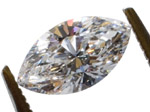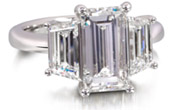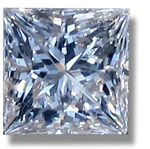It’s a Certified Diamond!
—
But who's saying so?
Official-looking diamond reports impress customers and persuade them to buy, but not all those diamond certificates are equal. Some are reliable, some look good but lack info, some are loaded with hype, and some are just plain fake. Here are some tips on how to judge diamond reports and how to use them.
The Role of a Report
Retailers find that diamond reports improve sales. Jewelry cases may display lab reports alongside the jewelry. Online companies often advertise “certified diamonds,” as though certification were some sort of seal of approval, some guarantee of high quality. It’s not.
The purpose of a diamond report, or diamond certificate, is to identify the gem and describe it in detail. That’s all.
A Good Diamond Report
 A diamond report that insurer and consumer can rely on is
A diamond report that insurer and consumer can rely on is
- detailed
- accurate
Details. The value is in the details. The report should describe all qualities of the gem in standard gemological language. This requires that the diamond be examined in a gem lab by a trained gemologist. A complete, detailed description assures the owner that the diamond is of the purported quality and, in the event of a loss, it helps an adjuster make a fair settlement.
A lab report doesn’t address valuation. Its concern is only the quality of the gem, not its current selling price.
Accuracy. How does the insurer, or the customer, know a lab report is accurate? As in all things where we are untrained, we rely on experts. And we look for experts with the best track records. Some diamond grading labs are more reliable than others.
Looking at Labs
A recent publication by National Jeweler listed more than 80 gem grading labs in the world! And many national labs are opening branches in other countries to meet the appetite for certificates.
 JCRS would love to be able to tell you that we’ve solicited reports from all of them and found the best ones. But a thorough, double-blind study of that magnitude would take $50,000 to $100,000 to complete — and no one has offered to fund it! So our recommendations are based on two things: diamond reports we’ve actually seen, and the reputations a lab has acquired among experts in the field.
JCRS would love to be able to tell you that we’ve solicited reports from all of them and found the best ones. But a thorough, double-blind study of that magnitude would take $50,000 to $100,000 to complete — and no one has offered to fund it! So our recommendations are based on two things: diamond reports we’ve actually seen, and the reputations a lab has acquired among experts in the field.
[NOTE: This newsletter deals with lab reports on white, or colorless, diamonds. Grading colored diamonds, also called “fancies,” is more like grading colored gems and will be discussed in a future issue of JII.]
For detail, looking at a diamond report is very telling. We want a report that gives the most detail, since all these details are used to determine the gem’s value.
 Besides the 4Cs of diamonds—cut, color, clarity and carat weight—the report should state whether the diamond is natural or synthetic. (Some labs do not grade synthetic diamonds.)
Besides the 4Cs of diamonds—cut, color, clarity and carat weight—the report should state whether the diamond is natural or synthetic. (Some labs do not grade synthetic diamonds.)
The report should also disclose any treatments, such as fracture filling or clarity enhancement. (Some labs do not issue grading reports for fracture-filled, or clarity enhanced, stones because the filling masks the color and clarity of the gem. An accurate assessment of color and clarity can be made only if the filling is removed—which would change the appearance of the stone and, with an extremely fractured stone, might even destroy it.)
For accuracy, we look to labs that have the best reputation for professional training and accuracy. We respect labs that are independent of selling jewelry.
 For example, we can’t recommend lab reports that include a valuation. The valuation is often significantly higher than the selling price, which suggests that valuation is inflated to make the sale price look good. That makes the report a sales tool, not a dependable analysis from a impartial lab. And if the valuation is inflated—that is, a lie—then the description of the gem is not to be trusted either.
For example, we can’t recommend lab reports that include a valuation. The valuation is often significantly higher than the selling price, which suggests that valuation is inflated to make the sale price look good. That makes the report a sales tool, not a dependable analysis from a impartial lab. And if the valuation is inflated—that is, a lie—then the description of the gem is not to be trusted either.
Reliable Labs
So which labs give the most trustworthy reports? We recommend GIA, AGS and GCAL.
GIA (Gemological Institute of America) established the color- and clarity-grading systems that are accepted throughout the world. A GIA report is the gold standard in diamond grading. For round brilliant diamonds, GIA gives information on cut geometry; for other shapes, unfortunately, the report lacks some crucial cut details. GIA issues separate reports for synthetic, or lab-grown, diamonds.
AGS Lab (American Gem Society Lab) issues reliable reports. It has full cut information for round brilliant, princess cut, square cut, emerald cut. Coming in late fall, in time for the holidays, it will be adding full geometry for oval and marquis cut diamonds, as well. AGS does not grade synthetic diamonds.
GCAL (Gem Certification & Assurance Lab) is also among the most reliable labs.
Its impressive report includes full cut geometry on round brilliant, princess, cushion. The report also has a photomicrograph of the stone’s inclusions. GCAL does not grade synthetic diamonds.
Two other highly respected labs are located outside the United States: Gübelin (based in Switzerland) and HRD (based in Antwerp). Although you would not seek out a report from a foreign-based lab, such reports may accompany jewelry purchased.
If your client presents a report from a lab not mentioned here, we strongly recommend that you look carefully at the appraisal and the credentials of the appraiser. For high-value stones, consider requiring a second lab report from one of the above labs.
Fake Certificates
The increasing reliance on gem certificates, along with a lucrative trade in fake gems, low-quality stones, and treated or “enhanced” gems, means there’s an increasing danger of counterfeit certificates. Some labs are introducing more security features on their reports to combat the problem. GIA, being the most prominent lab, is most likely to have its reports faked (see our issue on counterfeit GIA certificates), but others are also imitated.
 If the client presents a diamond certificate, or if the appraisal references a diamond report, always take a moment to verify the report’s authenticity on the lab’s Web site. GIA was the first to offer this service (very useful to insurers), and other labs have followed.
If the client presents a diamond certificate, or if the appraisal references a diamond report, always take a moment to verify the report’s authenticity on the lab’s Web site. GIA was the first to offer this service (very useful to insurers), and other labs have followed.
To verify authenticity of certificates from the recommended labs, follow the appropriate link. You will need the report number and the carat weight of the stone.
GIA Report Check
AGS Report Verification
GCAL Certificate Search
FOR AGENTS & UNDERWRITERS
A certificate from a reliable laboratory serves as authoritative verification of the qualities of the gem, and it is a highly recommended document for insuring high-value jewelry.
The most reliable labs for diamond certificates are GIA, AGS and GCAL.
Even a certificate from a reliable lab may be counterfeit or may have been written for another stone. Be sure to verify the authenticity of the report on the lab’s Web site.
A little trick to be aware of: Some manufacturers sell their diamond simulants (fake diamond) with certificates that give the color, clarity, carat weight, cut, brilliance, polish, etc. — but never actually say the stone is a diamond. If it isn’t even called diamond, you can be sure it’s not diamond.
A diamond certificate, even from a reliable lab, is not a substitute for an appraisal. Your best bet is to secure an appraisal that meets the insurance industry’s standards — a JISO 78/79 appraisal, preferably prepared by a Certified Insurance Appraiser™. (Some insurance companies give premium discounts for JISO appraisals.)
FOR ADJUSTERS
GIA, AGS and GCAL are the most reliable labs for diamond reports. If you are faced with a certificate from another lab, use caution. Always try to verify the certificate’s authenticity on the lab’s Web site.
If you’re dealing with a certificate supplied by the jewelry seller, be sure to verify the report’s authenticity. Besides the possibility of deliberate fraud, there’s also the possibility that the retailer himself was given a fraudulent certificate when he purchased the stone and he merely passed it on.
Do not rely on diamond reports that include a valuation. The qualities, as well as the valuation, will likely be inflated.
Especially for high-value jewelry, always compare all documents on file to be sure their descriptions agree. Check that the certificate and the appraisal are describing the same stone. Uncovering discrepancies can help avoid overpayment of settlements.
©2000-2025, JCRS Inland Marine Solutions, Inc. All Rights Reserved. www.jcrs.com

